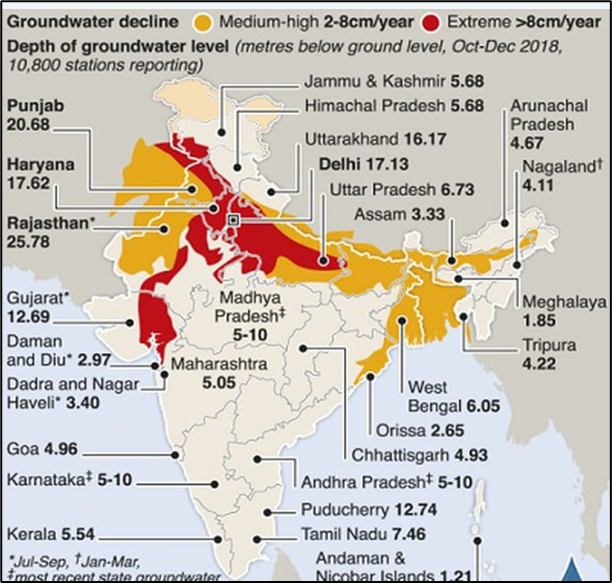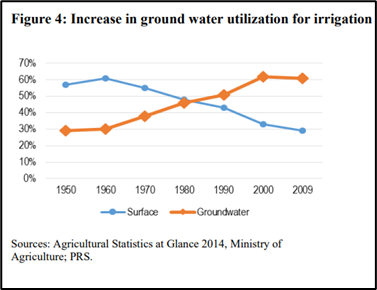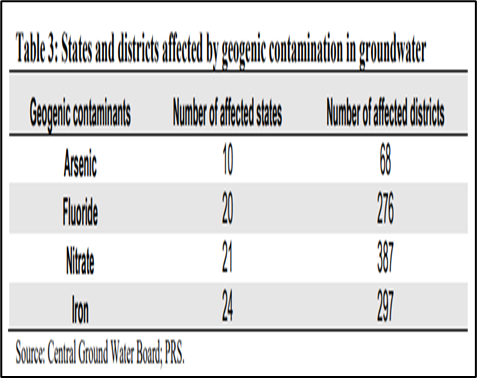Q) “The ground water crisis that India is currently witnessing, is an outcome of climate change or a result of anthropogenic factors”. Give your arguments.
Q) “The ground water crisis that India is currently witnessing, is an outcome of climate change or a result of anthropogenic factors”. Give your arguments.
Approach
Introduction: Mention relevant data and facts to highlight the deplorable state of groundwater levels in India.
Body: Give your arguments to highlight that the groundwater crisis is an outcome of climate change and then give arguments to highlight that it is also an outcome of anthropogenic factors.
Conclusion: Suggest what needs to be done.
Answer
According to Niti Aayog, groundwater, which is the source of 40% of India’s water needs, is depleting at an unsustainable rate and even the latest “Groundwater year book - India 2017-18”, has also pointed out that India is the world’s largest groundwater user, as it accounts for 12% of global groundwater extraction, pumping some 230 billion cubic meters each year. At this rate, by 2030, nearly 60% of the aquifers will be in a critical state.
Although on account of climate vagaries, India is receiving less rainfall but it is majorly on account of anthropogenic factors that groundwater levels are depleting at an unsustainable rate.
Groundwater crisis an outcome of climate change:
- Drought-prone regions have increased - According to the Council on Energy, Environment and Water (CEEW) report titled “ preparing India for extreme climate events” the yearly average of drought-affected districts increased 13 times after 2005. Until 2005, the no. of districts affected by droughts was six, but after 2005 this figure rose to 79. E.g., districts most prone to droughts include Rajkot (Gujarat), Anantapur (Andhra Pradesh), Aurangabad (Maharashtra), Barmer (Rajasthan) etc.
- Erratic rainfall - According to the 6th Assessment Report of the Intergovernmental Panel on Climate Change, there has been a noticeable decline in rainfall, with monsoon deficits occurring with greater frequency in various regions of South Asia. E.g. Maharashtra, Karnataka and U.P. faced severe water scarcity during 2015 due to record-breaking summers and weakening monsoons.
- El-Nino - According to the weather models on which the IMD relies, there is a certainty of an El-Nino weather phenomenon this year, on account of which India is likely to receive less monsoonal rainfall. According to IPCC, on account of climate change, it is likely that in future the El-Nino events would become stronger.
- Shift in the pattern of extreme climate events - According to a study released by the Council on Energy, Environment and Water (CEEW), flood–prone areas are becoming drought-prone and vice-versa in over 40% of Indian districts. This is also impacting the groundwater levels in India.
- Role of increased evapotranspiration - Evapotranspiration is the sum of all processes by which water moves from the land surface to the atmosphere via evaporation and transpiration. But due to climate change, we are going to witness increased evapotranspiration, which will limit water availability for groundwater recovery.
Groundwater crisis an outcome of anthropogenic factors -
- Irrigation through groundwater - The largest component of groundwater use is the water extracted for irrigation. Over the years, there has been a decrease in surface water use and a continuous increase in groundwater utilization for irrigation. The dependence of irrigation on groundwater increased with the onset of the Green Revolution, which depended on the intensive use of inputs such as water and fertilizers to boost farm
- Groundwater contamination - It is the presence of certain pollutants in groundwater that are in excess of the limits prescribed for drinking water. The commonly observed contaminants include arsenic, fluoride, nitrate and iron, which are geogenic in nature. Other contaminants include bacteria, phosphates and heavy metals which are a result of human activities including domestic sewage, agricultural practices and industrial effluents. So, nearly 60% of all districts in India have issues related to either availability of groundwater, or quality of groundwater, or both.
- Virtual water trade - It refers to the hidden flow of water in food or other commodities that are traded from one place to another. A global analysis of virtual water export reveals that India is a major water exporter country, which exports around 32 billion m3 of water or 1.6% of total available water and contributes a 24% share in the global virtual water export while virtual water import is almost negligible.
- Energy subsidies and groundwater extraction - The practice of providing power subsidies for agriculture has played a major role in the decline of water levels in India. In 2009, of the total amount of groundwater extracted, 89% was for irrigation, and 11% was for domestic and industrial uses. Since power is a main component of the cost of groundwater extraction, the availability of cheap/subsidized power in many states adds to the greater extraction of this resource.
- Unplanned urbanization: An increase in the built-up and paved area eliminates infiltration, reduces evapotranspiration, and thereby increases surface runoff and hence reducing the groundwater recharge. A study in the United States indicated that for every 1 per cent increase in the impervious surface area, there is a 3.3 per cent increase in the urban flood magnitude.
Thus, the deplorable state of groundwater levels that India is currently witnessing is on account of both climate change and anthropogenic factors. In order to address this situation India needs to adopt water-sensitive urban designs and planning by adopting interventions like rainwater harvesting, stormwater harvesting, rain garden and bioretention ponds etc. and lastly, we need to promote wastewater recycling in order to ensure sustainable groundwater management.
Click to View More



